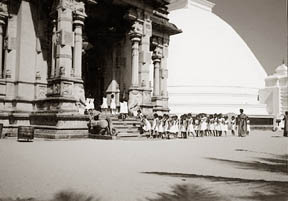|
observer |
|
|
|
|
|
OTHER LINKS |

|

|

|
"How I wish I could fall on my knees beside you..."Avalokitesvara Bodhisattva at Kelani Vihara
The gentle rustle of bo leaves, the soft murmur of gatha... the fragrance of incense ... staring at the deep look of devotion on the faces of the uppasakammas its hard not to recall the lines of Mahagama Sekara, - Kelani vihare sudu dagaba abiyasa ... (near the white dagaba at Kelani Vihara)... But today (November 26) will not be the same as other Sundays at this historical Raja Maha Vihara bordering the Kelani river. For, from today, the temple precincts will hold yet another significant monument, further enhancing the religious significance of the sacred grounds - hallowed by the visit of the Lord Buddha during the Buddhist era of 2531. From today, next to the dagaba which has its own unique shape of a heap of paddy, there will stand the statue of the Avalokitesvara Bodhisattva. Undoubtedly the most popular and most beloved of the bodhisattva, the statue, which would be unravelled today as a part of the shrine room is a replica of an already existing figure at the Kelani Vihara, created by Solias Mendis. With a height of 18 feet, this new figure of the Avalokitesvara Bodhisattva, according to Ven. Kollupitiye Mahinda Sangarakkitha Thera, Chief Incumbent of the Kelani Raja Maha Vihara, was carved in stone in Allagadda, in the Kurnool District of Andhra Pradesh, India. Listening to Ven. Sangarakkitha Thera it is hard not to wonder if the ancestors of the same stone carvers who carved the statue for the Kelani Vihara would have carved the statues of the Tirupathi temple, which is situated in close proximity to Allagadda. If so, an invisible link has surely been formed between these two sacred grounds of worship. Embodiment of compassion
Voicing the thoughts which are bound to come unconsciously into the minds of everyone whose eyes fall on the statue Ven. Sangarakkitha Thera says the worship of the Avalokitesvara Bodhisattva has long been popular and even fervent specially from 4th to 9th centuries. "According to Hugh Nevill there was an Avalokitesvara statue at Kelani Vihara in the 16th century which was destroyed by foreign invaders. There are other Avalokitesvara statues in Maligawila, Buduruwagala, Kushtarajagala, Situlpavwa and Dambulla". With Avalokita in Sanskrit meaning "looking on" while isvara means lord, it is safe to assume that the literal meaning of 'Avalokitesvara' is 'the Lord who looks ..., the implication being that he looks on with perfect compassion. As clearly depicted in the statue this bodhisattva is an all seeing and all helping deity, ready to acknowledge and support all suffering beings. "He supremely exemplifies the bodhisattva's resolve to postpone his own Buddha hood until he has helped every being on earth achieve emancipation." explains Ven. Sangarakkitha thera. SolaceThe pilgrims who make their way to the Kelani Vihara can now invoke the blessings of Avalokitesvara bodhisatva and seek solace for their woes, for in chapter 24 of the Lotus Sutra he is seen as a figure who can be called upon in times of adversity: 'If some creature, young man of good family, shall be bound in wooden or iron manacles, chains or fetters, be he guilty or innocent, then those manacles, chains or fetters shall give way as soon as the name of the Bodhisattva Mahasattva Avalokitesvara is pronounced'. Similarly, he can grant whatever one desires: 'If a woman is desirous of getting a daughter, a nice, handsome, beautiful girl shall be born to her; one possessed of the (good) characteristics of a girl, generally beloved and winning, who has planted good roots'. The Lotus Sutra also emphasizes Avalokitesvara's chameleon-like nature, assuming different guises appropriate to his audience:'To those who are to be converted by a goblin, he preaches the law assuming the shape of a goblin'. He is described as possessing the perfection of all virtues', beholding 'all beings with compassion and benevolence'. Staring at this new statue at the Kelani Vihara, it is hard, (yet again), not to recall the lines of Mahagama Sekara .... when you kneel ".... at Kelani Vihara, with such deep devotion, how I wish I, who do not believe in gods or deities could cast my beliefs aside and fall down on my knees beside you." |



 Contrary to the popular forms of the Avalokitesvara Bodhisatva, often
depicted with a number of heads, between two and eleven, and up to a
thousand arms the statue at Kelani Vihara presents a handsome young
prince holding a lotus in one hand. The flower is an inspirational
symbol in itself for, though it has its roots in mud and slime, the
lotus blossoms into a beautiful flower signifying that even though one
dwells in ignorance, one has the potential to grow into an enlightened
being. The figure as a whole by itself embodies infinite compassion.
Contrary to the popular forms of the Avalokitesvara Bodhisatva, often
depicted with a number of heads, between two and eleven, and up to a
thousand arms the statue at Kelani Vihara presents a handsome young
prince holding a lotus in one hand. The flower is an inspirational
symbol in itself for, though it has its roots in mud and slime, the
lotus blossoms into a beautiful flower signifying that even though one
dwells in ignorance, one has the potential to grow into an enlightened
being. The figure as a whole by itself embodies infinite compassion. 






